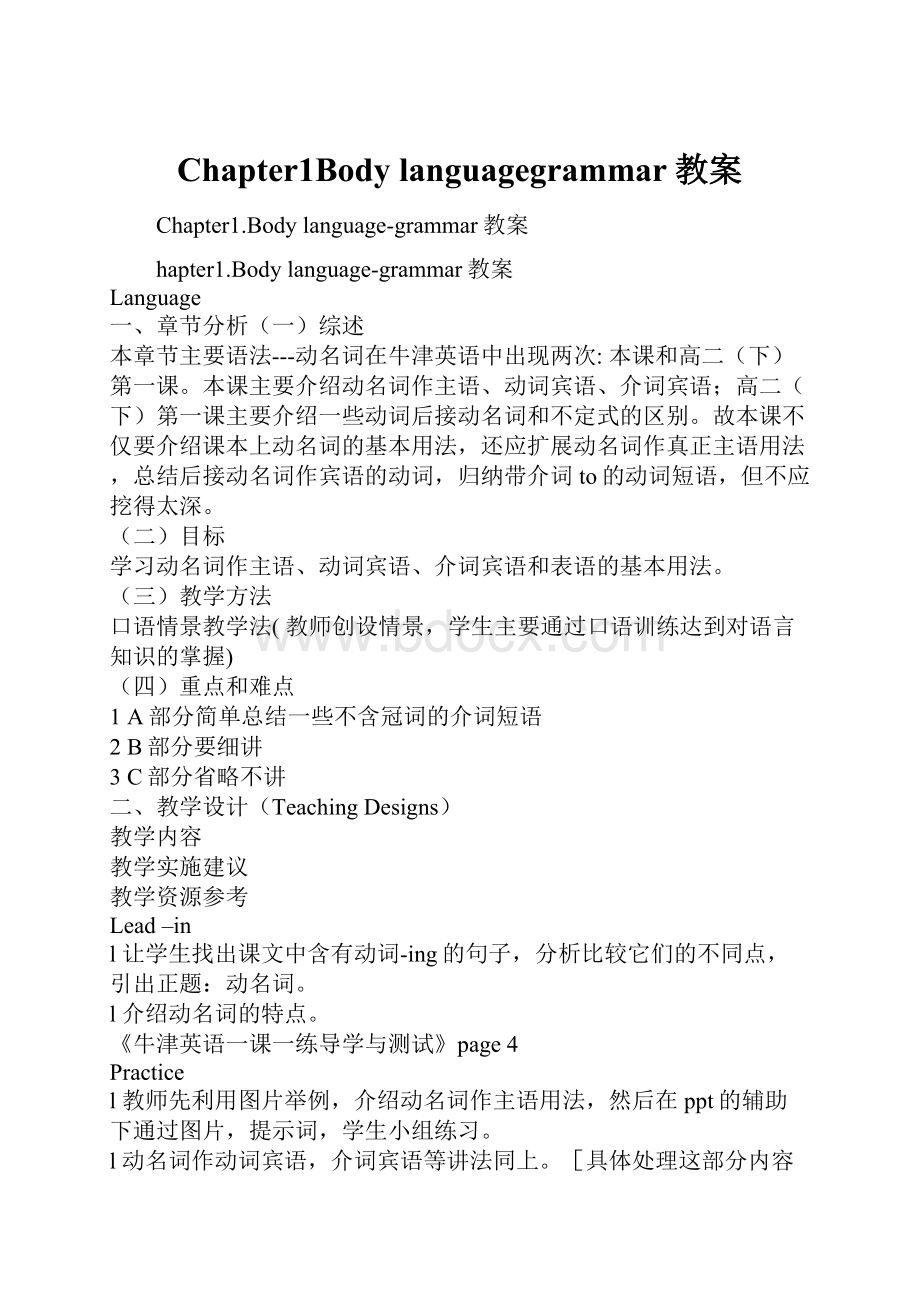Chapter1Body languagegrammar教案.docx
《Chapter1Body languagegrammar教案.docx》由会员分享,可在线阅读,更多相关《Chapter1Body languagegrammar教案.docx(7页珍藏版)》请在冰豆网上搜索。

Chapter1Bodylanguagegrammar教案
Chapter1.Bodylanguage-grammar教案
hapter1.Bodylanguage-grammar教案
Language
一、章节分析
(一)综述
本章节主要语法---动名词在牛津英语中出现两次:
本课和高二(下)第一课。
本课主要介绍动名词作主语、动词宾语、介词宾语;高二(下)第一课主要介绍一些动词后接动名词和不定式的区别。
故本课不仅要介绍课本上动名词的基本用法,还应扩展动名词作真正主语用法,总结后接动名词作宾语的动词,归纳带介词to的动词短语,但不应挖得太深。
(二)目标
学习动名词作主语、动词宾语、介词宾语和表语的基本用法。
(三)教学方法
口语情景教学法(教师创设情景,学生主要通过口语训练达到对语言知识的掌握)
(四)重点和难点
1A部分简单总结一些不含冠词的介词短语
2B部分要细讲
3C部分省略不讲
二、教学设计(TeachingDesigns)
教学内容
教学实施建议
教学资源参考
Lead–in
l让学生找出课文中含有动词-ing的句子,分析比较它们的不同点,引出正题:
动名词。
l介绍动名词的特点。
《牛津英语一课一练导学与测试》page4
Practice
l教师先利用图片举例,介绍动名词作主语用法,然后在ppt的辅助下通过图片,提示词,学生小组练习。
l动名词作动词宾语,介词宾语等讲法同上。
[具体处理这部分内容的建议见[衔接1;课件:
gerund]
l拓展动名词作真正主语用法,总结带动名词作宾语的动词,归纳带介词to的动词短语。
l[具体处理拓展部分内容的建议见[衔接2]。
图片可扫描书上
P0
《牛津英语教学参考》Page5-10
Exandhomework
l学生写一段话,尽量多用刚学的动名词;
l学生做一些教师精选的单项选择,以便巩固所学语法。
[具体处理这部分内容的建议见[衔接3]。
[链接1]
说明:
这是一份关于动名词的基础教学的教案与课件。
lead-in
1Askstuddwhichhavv.+ingxt.
(possibleanswers):
Hegaveanencouragingsmile.
Communicatinganspeakingandlisteningldingherheadup.
2Explaaningandfeaturesofgerunds.
Gerundsare–ingnouns.Itisakindofnouabovly“communicating,speaking,andlistening”aregerunds.Asanoun,gerundscanbeusedassubject,verbobbdicativeandattributivTwoPresentaGerundsassubjects
1)Example:
T:
Whatdoesshakinghandsmean?
S1:
Shakinghandsisasigdship.
S2:
Shakinghandsmeansthatyouadly.
(动名词作主语时,位于动词用单数)
2)Praudentspractiseaccordingxample.Theywaakesquusinguresandturningtheverbsinbra–ingnouns.S2answbox.
Shakingyouasignofanger.
Sighingisasignofsadness.
Yawningmeansthatyouaresleepy.
Closingyouansthatyouag.
Whistlingmeansthatyouarehaatchingyourheadmeansthatyouag.
Bowingisasig(补充讲解句型Itis(was)nouse/gooddoingg.)
2Gerundasverbobjects
1)Example:
T:
Ididn’tknowyoucouldswim.
S:
Didn’tyou?
Ilove/likeswimming.
T:
SodoI.Ireallwimming.
Idon’t.Ihate/dislikeswimming.
Iwalking.
2)Practice:
Studentswaakesimilardialoguesabouures.Followtheexample.
3)Tellstudverbswhichhavesuchusages.
admit,appreciate,avoid,bewldeny,delaape,prauggallowbid,consider,imagine
3Gerundsadayatwork,Debbiesawgs.Shedidn’tknowwhattheywaskedMrYang.
Walversation.S2shouldanswerS1,using–ingnounsmadverbboxalongwith“for”.
1)Example:
T:
Excuseme,butwhata_keys_____for?
S:
They’re_for______locking_____thedrawdesk.
2)Practice:
Studentswaakesimilardialoguesabouures.Followtheexample.
S1:
Andthis_______?
S2:
It’s_______________l:
Whatabou_______________?
S2:
They’re_______________yourpapertog:
This________.What’?
S2:
It’s______________thedatesondocu:
Andthese________?
S2:
They’re_______________.They’reaudayatwork.
(补充总结含介词to的动词短语:
be(get)usedto,getdownto,lookforwardto,leadto,payabedevotedto,ob例如:
Let’sgetdowntotalkingaboutyourfuture.
I’mlookforwardtohearingu.)
(见课件:
gerund)
[链接2]
说明:
这是动名词的拓展部分,拓展了动名词句型、接动名词做宾语的一些动词、接动名词做宾语的含介词to的一些动词短语等用法,教师可选择使用。
1下列句型后用动名词
1)It’snouse/gooddoing…
2)T(in)doing…
3)It’sworthdoing…
4)…can’thelpdoing…
〖典型例句〗
1)It’snougovltmilk.
2)Theplaceiswellworthvisitingagain.
3)Tatingxam.
4)Wecan’thelplaughinga)It’snogoodcopyingothers’homework.
2下列动词后常接动名词做宾语
1)admit,appreciate,avoid
2)complder
3)delay,deny
4)endure/standape,excuse
5))imagine
7)keep
8)mind)actice
10))suggest
巧记这些动词的诀窍:
继续坚持勿停止;盼望完成莫推迟
错过成功会后悔;惯于冒险须放弃
避免原谅不逃脱;忙于欣赏禁不住
介意练习很值得;考虑建议末延迟
想象无用已无益;记得做过勿忘记
禁止使用不定式
〖典型例句〗
1)Iadingbbedthougagoodhabit.
2)Ican’timaginegoingtoanyplacewithoutyou.
3)Wouldyoumindopeningthed?
4)HesuggestsreadingEnglisheveryday.
5)Thebirdmissedbeing)Heescapedbeingpunishedbyrunningaway.
3下列动词短语种to为介词
1)be(get)usedto
2)getdownto
3)lookforwardto
4)paya)bedevotedto
6)ob)leadto
〖典型例句〗
1)Iusedtogetuplate,butnowI’musedtogettingupearly.
2)Afterdiscussingwdeskmate,hegotdowntowriting)I’mlookingforwardtohearingu.
以下几点可以在以后单元里讲解:
1)need/want/require句型
2)love,like,hate后接todo与doing作宾语的区别
3)ber,regan,gget后接todo与doing作宾语的区別
4)allowder,advise后接todo与doing作宾语和宾补的区别
5)动名词的时态和语态
6)动名词的复合结构
[链接3]
说明:
这是针对动名词的一些练习。
Ⅰ单选:
1.Dg_____,willyou?
ABavingtriedD.trying
2.Wearealllookingforward______xtweek.
ABgC.atseeingDg
3.Hall______alexamination.
AareBaringaringDaring
4.Theblyfiveyearsold,buquiteused_____thetelA.toanswerB.toansweringC.ofansweringD.byanswering
5.______soundlyisburillnessthantakingmedA.TosleepB.SleepingC.SleepD.Havingslept
6whenIlIfeellike______awA.tomakeB.makingC.makeD.togofor
7.Iconsider_____ofevakindofmurder.
A.takingB.atakingakingD.totake
8.Mygrandfaarichman,but______moneydlveallblems.
A.hasB.tohaveC.havingD.havinghad
9.Igood______uA.toexpectB.expectingxpectingDxpect
10.Tbookworth______.
A.readB.ofreadingC.beingreadD.reading
11.Heliked______manyquaA.beingaskedB.askingC.ofaskingD.ask
12.Wehadnotrouble______thepaththrougAdBdingC.findingD.withfinding
II.用括号里的动词的正确形式填空:
1.Hdon_______(do)thewway.
2.Thewindowswant/need/requiretobecleaned.Thad/want/require_____(clean).
3.Hepracticed_______(play)thepianoeverydadoesn’tmind______(work)ovItwillmean______(benefit)yourcompanyandHaveyoudecidedtoputoff______(go)aside?
7.P(on)______(ask)quIt’sawa______(argue)abou_____(talk)iseasierthandoing.
10.Haveyoud_______(do)yourhomework?
III.翻译:
1.______(每天晨读一刻钟)isvantinlearningEnglish.
2.It’snouse_______(叹气).
3.Debb_______(微笑着与客户交流)asjustgivenup______(吸烟).
5.I______(一直盼望着访问)Chinaagain.
6.Heruavoid______(看见)byhisclassteaThisma______(切纸).
8.Thisbookiswellworth______(读).
9.______(挥动拳头)isasignofanger.
10.Mr.Yangsuggested/advised______(看着顾客的眼睛)tomakeagoodIV.拓展题:
1.---Youwerebraveenoughtoraiseobag.
---Well,nowIregret_____that.
A.todoB.tobedoingavedoneD.havingdone
2.Thepatientwaswarned_____oilyfoodaation.
A.toeatnotB.eatingatD.noteating
3.Shelwardevgto_____theflower-linedgarden.
A.visitB.payingavwalkinD.walkingin
4.Thelittletimewehavetogetherwetry_____wisely.
A.spendingitBddD.spendingthat
5.Whilg,peoplan’thelp______intobuyinggtheydon’treallyneed.
AuadeB.persuadingD.beingpersuadedD.bepersuaded
6.Whatworriedldmostwas______toval.
AallowingBbeingallowedbeingnotallowedD.havingnotbeenallowed
7.Tonywasveryunha_____arty.
A.havingnotbeeninvitedB.nothavinginvited
C.havingnotinvitedD.nothavingbeeninvited
8._____tosunliguwilldoha’A.ExposedB.HavingexposedC.BeingexposedD.Afterbeingexposed
9.Thediscovwevidenceledto_____.
AavingcaughtB.cabeingcaughtDbecaught
10.Onelearnsalanguagebymakingmistakesand_____ABgD.---Youshouldhavethankedherbuleft.
---Imeant_____,butwhenIwasleavingIcouldn’tfindheranywhere.
A.todoBdoingD.doing
12.IartsofLondgabusmeans_____foraur.
A.waitingB.towaitC.waitD.tobewaiting
13.---What’smadangry?
---______A.LoseB.ToloseC.BecauseoflosingD.Losing
14.Thedaywearelookingforwardto_______atlast.
A.arrivingB.arriveC.arrivedD.arrivReedmadeudtodevoteallhehadto____lldren.
A.setupBgupC.havesetupD.havingsetup
附答案:
Ⅰ.单选:
DDCBBBCCBDBC
Ⅱ.用括号里的动词的正确形式填空:
doing,cleaning,playing,working,bg,
going,asking,arguing,Talking,doing
Ⅲ.翻译:
1.Readingforaquaanhourevg
2.sighingunicatingwithcuwithasmilg
5.amlookingforwardtovisiting
6.beinguttinguppaading
9.Shakingone’0.lookingatcustomers’eyes
Ⅳ.拓展题:
DCDBDBDCCBBADCB